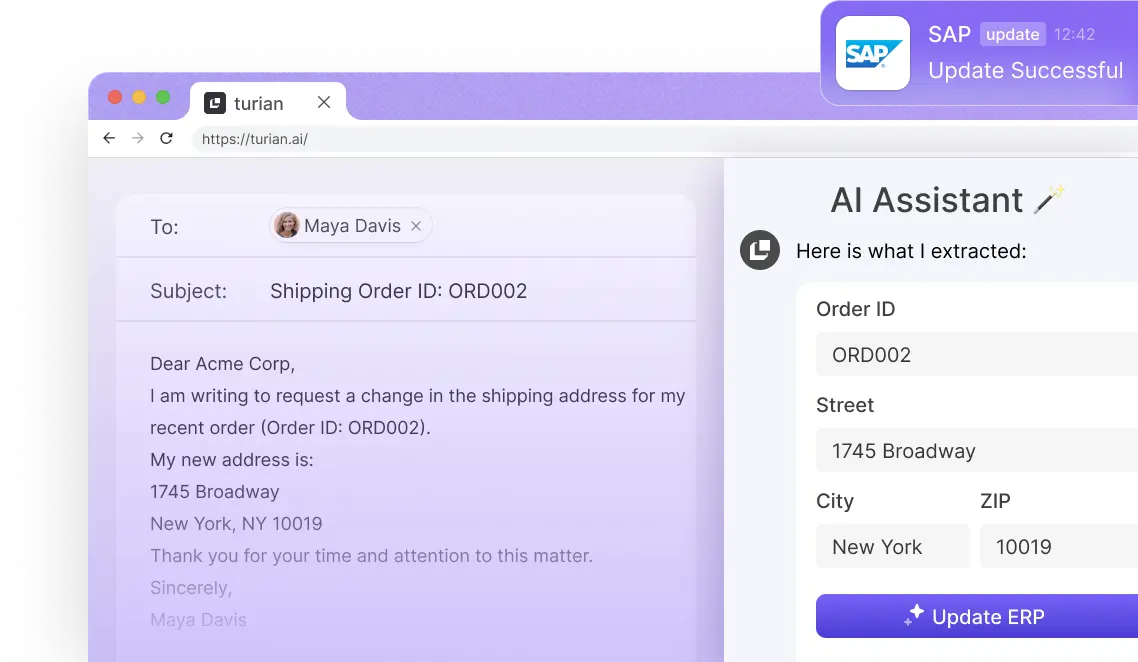

AI Order Processing: Automating sales orders with generative AI
Order management is the backbone of any business; from small startups to Fortune 500 firms, efficient and streamlined order processing is the "make it or break it" factor when it comes to success. However, let's be honest: traditional order management can be a pain in the neck.
The manual processes (particularly data entry and validation), endless paperwork, and human errors not only slow down the whole process but also result in lost time, money, and customer satisfaction. To address these headaches, leading businesses have turned to artificial intelligence (AI) to automate their order management system. Why? Well, it's simple: AI is like a super-efficient assistant that never sleeps or gets tired and very rarely makes mistakes. It can handle complex tasks, crunch large amounts of data, and make decisions in a fraction of the time it takes for humans.
In this blog post, we'll explore what exactly AI order processing is, how it works, and, most importantly, how it can streamline your business's order management system to boost efficiency and drive growth.
What is AI Order Processing?

Image Credit : Freepik
AI order processing is a cutting-edge approach that leverages the power of Large Language Models (LLMs) to automate and optimize the order management process in a B2B environment. From handling purchase orders to managing inventory levels, AI can streamline the entire order lifecycle.
Unlike traditional methods bogged down by manual tasks and human error, AI order processing utilizes advanced algorithms and machine learning to ensure accuracy, speed, and efficiency.
But this technology is not just about automating routine tasks. It can help with other aspects of B2B order management as well, which include:
- Streamlining communication with suppliers and customers.
- Providing real-time updates on order status and delivery.
- Running analytics on your sales order data for data-driven decision-making
- Predicting customer demand to optimize inventory levels.
- Identifying anomalies and potential fraud in orders.
With AI order processing, businesses can not only save time and resources but also improve customer satisfaction through lower response times and fewer errors.
How Does AI Order Processing Work?
An AI order processing system consists of several crucial components that work together to automate the order management process end-to-end. These components can be either modular parts of an extensive software platform or standalone solutions integrated into the broader system. Ok, it sounds fancy and all, but how does it actually work? Well, let's break it down into 4 simple steps:

1) Open and Read Documents:
The first step in AI order processing is to open and read incoming documents. It identifies and classifies them based on predefined parameters, such as file format or document type. The AI can handle various file formats like Word, PDF, Excel, CSV, XML, email free texts, and even images taken by phone.
2) Data Entry & Cross-Validation:
Once the documents are identified, AI can extract relevant data in a structured form, such as product details, price, quantity, customer data, and commercial terms. After extraction, the data is matched against existing records in your ERP system, ensuring accuracy and consistency. Any discrepancies or missing information can be flagged for manual review.
3) Quotation & Order Generation:
Using the extracted data, AI can generate quotes or new sales orders automatically. This process significantly reduces the time and effort required to create these documents manually.
4) Customer Communication:
The time-consuming task of drafting personalized email responses to customers is also automated using AI. By analyzing previous interactions and customer preferences, the AI can generate personalized emails in the appropriate language and tone for each customer. But it doesn't just process orders. AI can also proactively follow up with customers, keeping them informed about their order status, delivery updates, and any issues that may arise like asking for missing data.
There are also other components that can be included in an AI order processing system, like fraud detection, inventory management, and more. The main goal remains the same: to automate and optimize the order management process for maximum efficiency and accuracy.
Benefits of AI Order Processing: How It Can Help Your Business?
We've talked a lot about AI order processing and how it works, but let's get to the $64 question: how can it benefit your business?

Improved Efficiency and Accuracy:
Slow input methods cause delays, while human errors like typos can lead to incorrect orders. By using AI to do the same stuff over and over, like manual data entry, cross-validations in the ERP system, and generating order confirmations or quotes, employees can focus on the really important tasks. This means:
- Increased productivity and output.
- More time for strategic decision-making and customer relationship-building.
- Minimized delays and bottlenecks.
Lower Operational Costs:
Finding ways to cut costs without compromising quality is essential for long-term growth. With AI order processing, businesses can automate time-consuming tasks and streamline processes to reduce operational costs. This means you can invest your resources in other areas that need attention, like marketing, customer service, or product development.
Improved Customer Satisfaction:
It doesn't matter how great your products or services are; if your customers don't have a positive buying experience, they won't come back. The result: lost sales, negative word-of-mouth, and a potentially damaged reputation. With AI order processing, businesses can ensure faster and more accurate order fulfillment, leading to happier customers. From real-time updates on order status to auto-generated smart replies, AI makes sure that customers are always in the loop.
Scalability:
With traditional order processing methods, businesses often struggle to handle an increase in orders and maintain the same level of efficiency. What they do: hire more staff or outsource the work to a third party, which can be both costly and time-consuming. An automated AI system enables businesses to easily handle more orders without increasing overhead costs. It not only saves time, money, and resources but also allows for seamless scalability.
If you're a B2B business owner or sales service manager looking to reduce your workload and scale and grow your operations, then we at turian have just the solution for you. With our AI order processing system, you can remove up to 80% of your team's administrative work and save thousands of hours per year spent on data entry and order processing.
Our AI assistant runs right next to your inbox and can understand email text as well as attached documents like PDFs, spreadsheets, or CSVs, just like a human employee would. Plus, there's no need for lengthy model training processes or using supplier portals; we simply connect to your email inbox and ERP system, and you are good to go. Done within just a few days. You can book a demo right now to get an impression of our AI assistant.
How to Implement an AI Order Processing System in Your Business

Well, with a bit of planning and the right provider, implementing AI order processing in your business is much simpler than you think. Here are the steps you can take to get started:
Understand Your Business Needs and Goals:
Before implementing any AI order processing system, it's crucial to assess your current ordering and fulfillment processes. Identify areas that bring the most and least value and which processes are requiring a lot of manual labour, like manual data entry, repetitive tasks, or approvals, and prioritize them accordingly. Also, paint a clear picture of your goals and objectives, whether it's reducing processing time, scaling your order management capacity or improving accuracy. With this information, you can better measure the success of your automated system and make data-driven decisions.
Choose the Right AI Order Processing System:
There are a handful AI order processing systems out there, each with its own features and capabilities - although we believe, for a number of reasons, that our solution is best-in-class ;-) It's essential to choose a provider that best sticks to your business needs and goals. Look for a system that can be implemented cheaply and within a short time, integrate seamlessly with your existing technology stack, has a user-friendly interface, and offers customizable options to tailor it to your specific requirements. Out-of-the-box solutions usually don’t work well in specific scenarios, so make sure the solution can adapt to your very nichey workflows. Make sure you understand what technology is actually used: AI is not always AI, and there are big differences in the performance of technologies and models.
At turian, our AI assistant is designed specifically for B2B businesses and can be easily integrated with tools that you're already using, like Gmail, MS Dynamics 365, Salesforce, or even your internal communication systems. Our solution can go live within 2 weeks and requires no pre-training on your data. We can adapt to your highly individual workflows so the AI can atually take over the heavy lifting. With minimal effort from your side, you can automate your entire order-processing workflow in one place.
Train Your Team and Monitor the Process:
The success of any AI order processing system relies on two key factors: training and monitoring. It's crucial to train your team on how to use the new system and familiarize them with its features and functionalities. This will not only ensure a smooth transition but also help in identifying any gaps or issues that may arise during the process.
You'll need to continuously monitor and optimize your new ordering processes to ensure they are meeting your goals and providing the intended benefits. Also, evaluate operational performance data based on the goals you've set and make data-driven decisions to improve your strategies and optimize ROI.
With turian, you’ll have a super easy-to-use and intuitive user interface (UI) integrated directly into your email client (e.g. Outlook or Gmail). No need to learn and adapt to a new software. Your teams will love our AI Assistant and can learn to use it within minutes. In addition, our flexible analytics dashboard automatically collects and displays all the relevant information so you have full overview and control over your order entry process.
Streamline Your Order Processing with turian:
Our AI assistant offers a groundbreaking solution that can transform your entire order-processing workflow. With turian, you can eliminate manual data entry and reduce administrative work by up to 80%. Not only does turian save you time, but it also ensures accuracy, data consistency and speeds up client communication with its intelligent email processing capabilities. It can seamlessly integrate with your ERP systems and email clients and is ready-to-use within a few days.
We're making your employees and customers happier by reducing workloads, errors and handling times. Your customers will receive their products faster, and you will get your money quicker. And with its rule-based policies and data security measures, you can have peace of mind that you always stay in control of crucial processes. If you want to experience the benefits of turian for yourself, book a demo now and see how it can streamline your order processing.
{{cta-block-blog}}

Say hi to your
AI Assistant!


Lernen Sie Ihren KI-Assistenten kennen!
.avif)
FAQ
Any business that deals with orders and fulfillment can benefit from an AI order management system. However, it is especially useful for B2B businesses that have a high volume of orders, a diverse product palette, and require efficient, accurate, and timely processing.
Unlike traditional methods, where every step of the order processing is done manually, AI order processing automates many tasks, making the process faster and more accurate. Compared to rules-based technology (e.g. OCR), AI has significantly higher accuracy rates without the need for costly training. AI order processing solutions can handle a high volume of orders, ensure real-time updates, and integrate with relevant systems (e.g. your email client and ERP software), making it a more efficient and streamlined approach. In addition, it can also learn and improve based on data, making it smarter over time.
While AI order processing has the potential to automate certain tasks like data entry and taking orders, it is not meant to replace human employees. It is more of a tool that can assist employees in their work and improve overall efficiency. It helps human employees use their time for really important tasks, such as client communication and strategy. In other words, it saves time and effort, not replace jobs.
An AI order processing system can handle various types of data, including product information, customer data, commercial terms, and any other relevant information found in emails or attachments. It can open and read incoming documents of various formats, like Word, PDF, XML, EXCEL, and even scanned images.





